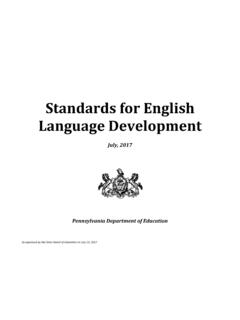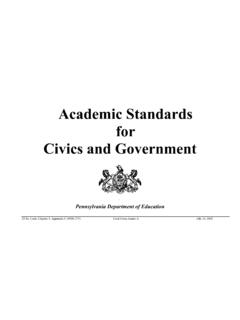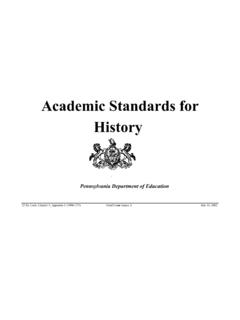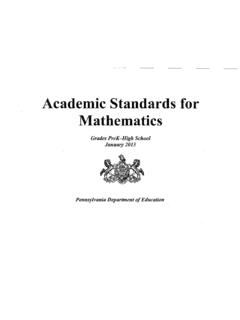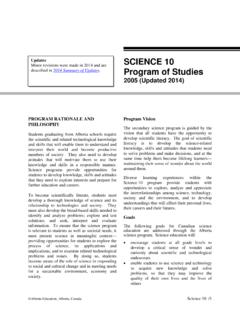Transcription of Academic Standards for Science and Technology
1 Academic Standards for Science and Technology Pennsylvania Department of Education 22 Pa. Code, Ch. 4, Appendix B Final Form January 5, 2002 Academic Standards for Science and Technology VII. TABLE OF CONTENTS VIII. THE Academic Standards Unifying Themes .. A. Systems B. Models C. Patterns D. Scale E. Change Inquiry and Design .. A. Nature of Scientific Knowledge B. Process Knowledge C. Scientific Method D. Problem Solving in Technology Biological Sciences .. A. Living Forms B. Structure and Function C. Inheritance D. Evolution Physical Science , Chemistry and Physics .. A. Matter B. Energy C. Forces and Motion D.
2 Astronomy Earth Sciences .. A. Land Forms and Processes B. Resources C. Meteorology D. Hydrology and Oceanography Technology Education .. A. Biotechnology B. Information Technology C. Physical Technologies (Construction, Manufacturing, and Transportation) Technological Devices .. A. Tools B. Instruments C. Computer Operations D. Computer Software E. Computer Communication Systems Science , Technology and Human Endeavors .. A. Constraints B. Meeting Human Needs C. Consequences and Impacts Glossary .. IX. 22 Pa. Code, Ch. 4, Appendix B Final Form January 5, 2002 Academic Standards for Science and Technology VIII. INTRODUCTION This document describes what students should know and be able to do in the following eight areas: Unifying Themes of Science Earth Sciences Inquiry and Design Technology Education Biological Sciences Technological Devices Physical Science , Chemistry Science , Technology and Human Endeavors and Physics These Standards describe what students should know and be able to do by the end of fourth, seventh, tenth and twelfth grade.
3 In addition, these Standards reflect the increasing complexity and sophistication that students are expected to achieve as they progress through school. This document avoids repetition, making an obvious progression across grade levels less explicit. Teachers shall expect that students know and can apply the concepts and skills expressed at the preceding level. Consequently, previous learning is reinforced but not retaught. Standards are arranged by categories, for example, Earth Science . Under each category are standard statements that are preceded by a capital letter; for example, in Unifying Themes, grade , "Describe concepts of models as a way to predict and understand Science and Technology ." Following the standard statements are bulleted standard descriptors, which explain the nature and scope of the standard. Descriptors specify the nature of the standard and the level of complexity needed in meeting that standard in a proficient manner. Descriptors serve to benchmark the standard statement.
4 Curriculum, instruction and assessment should focus on meeting the standard statement. Technology Education, computer applications and Science are separate curricular areas. Meeting Standards should be approached as a collaborative effort among all curricular areas. 22 Pa. Code, Ch. 4, Appendix B Final Form January 5, 2002 1 Academic Standards for Science and Technology The following descriptors explain the intent of each standard category: Unifying Themes Inquiry and Design Biological Sciences Physical Science Chemistry and Physics Unifying themes of Science and Technology provide big ideas that integrate with significant concepts. There are only a few fundamental concepts and processes that form the framework upon which Science and Technology knowledges are organized - motion and forces, energy, structure of matter, change over time and machines.
5 These themes create the context through which the content of the disciplines can be taught and are emphasized in each standard. The nature of Science and Technology is characterized by applying process knowledge that enables students to become independent learners. These skills include observing, classifying, inferring, predicting, measuring, computing, estimating, communicating, using space/time relationships, defining operationally, raising questions, formulating hypotheses, testing and experimenting, designing controlled experiments, recognizing variables, manipulating variables, interpreting data, formulating models, designing models, and producing solutions. Everyone can use them to solve real-life problems. These process skills are developed across the grade levels and differ in the degree of sophistication, quantitative nature and application to the content. Biology concerns living things, their appearance, different types of life, the scope of their similarities and differences, where they live and how they live.
6 Living things are made of the same components as all other matter, involve the same kinds of transformations of energy and move using the same basic kinds of forces as described in chemistry and physics Standards . Through the study of the diversity of life, students learn to understand how life has changed over a long period of time. This great variety of life forms continues to change even today as genetic instructions within cells are passed from generation to generation, yet the amazing integrity of most species remain. Physics and chemistry involve the study of objects and their properties. Students examine changes to materials during mixing, freezing, heating and dissolving and then learn how to observe and measure results. In chemistry students study the relationship between matter, atomic structure and its activity. Laboratory investigations of the properties of substances and their changes through a range of chemical interactions provide a basis for students to understand atomic theory and a variety of reaction types and their 22 Pa.
7 Code, Ch. 4, Appendix B Final Form January 5, 2002 2 Academic Standards for Science and Technology applications in business, agriculture and medicine. Physics deepens the understanding of the structure and properties of materials and includes atoms, waves, light, electricity, magnetism and the role of energy, forces and motion. Earth Sciences The dynamics of earth Science include the studies of forces of nature that build the earth and wear down the earth. The understanding of these concepts uses principles from physical sciences, geography and mathematics. Technology Education Technology education is the use of accumulated knowledge to process resources to meet human needs and improve the quality of life. Students develop the ability to select and correctly use materials, tools, techniques and processes to answer questions, understand explanations and solve problems encountered in real life situations.
8 These overriding themes require students to design, create, use, evaluate and modify systems of Biotechnologies, Information Technologies, and Physical Technologies. Technological Devices Students use tools to observe, measure, move and make things. New technological tools and techniques make it possible to enact far-reaching changes in our world. Technology enhances the students' abilities to identify problems and determine solutions. Computers play an integral role in every day life by extending our abilities to collect, analyze and communicate information and ideas. Science , Technology and Human Endeavors Scientific knowledge and societal needs often create a demand for new Technology . Conversely,new Technology advances scientific knowledge. Both influence society through the impact of their products and processes. 22 Pa. Code, Ch. 4, Appendix B Final Form January 5, 2002 3 Academic Standards for Science and Technology What Is Science ?
9 Any study of Science includes the search for understanding the natural world and facts, principles, theories and laws that have been verified by the scientific community and are used to explain and predict natural phenomena and events. Acquiring scientific knowledge involves constructing hypotheses using observation and knowledge in the content area in order to formulate useful questions that provoke scientific inquiry. As a result of repeated, rigorous testing over time and applying multiple perspectives to a problem, consistent information emerges. A theory describes this verifiable event or phenomena. Theories are powerful elements in Science and are used to predict other events. As theories lose their ability to predict, they are modified, expanded or generalized or incorporated into a broader theory. Knowledge of what Science is incorporates carefully developed and integrated components: Nature of Science -- the ways in which scientists search for answers to questions and explanations of observations about the natural world; includes process knowledge of observing, classifying, inferring, predicting, measuring, hypothesizing, experimenting and interpreting data Unifying themes of Science -- concepts, generalizations and principles that result from and lead to inquiry Knowledge -- facts, principles, theories and laws verifiable through scientific inquiry by the world community of scientists.
10 Includes physics, chemistry, earth Science and biological sciences Inquiry -- an intellectual process of logic that includes verification of answers to questions about and explanations for natural objects, events and phenomena Process skills -- Recognition by students how knowledge is acquired and applied in Science by observing, classifying, inferring, predicting, measuring, computing, estimating, communicating, using space/time relationships, defining operationally, formulating hypotheses, testing and experimenting, designing controlled experiments, recognizing variables, manipulating variables, interpreting data, formulating models, designing models and producing solutions. Problem solving -- application of concepts to problems of human adaptation to the environment that often leads to recognition of new problems; has social implications and leads to personal decision-making and action; a process which forms the link for interactions between scientific and technological results or findings; involves operational definitions, recognizing variables, formulating models and asking questions Scientific thinking -- the disposition to suspend judgment, not make decisions and not take action until results, explanations or answers have been tested and verified with information.
